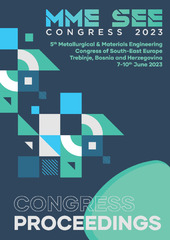Приказ основних података о документу
The adsorption of arsenic(v) ions from aqueous solutions by composite of natural polymer and metal oxide
| dc.contributor | Sokić, Miroslav | |
| dc.contributor | Marković, Branislav | |
| dc.contributor | Manojlović, Vaso | |
| dc.creator | Živanić, Janko | |
| dc.creator | Bugarčić, Mladen | |
| dc.creator | Antanasković, Anja | |
| dc.creator | Lopičić, Zorica | |
| dc.creator | Sokić, Miroslav | |
| dc.creator | Jovanović, Aleksandar | |
| dc.creator | Milivojević, Milan | |
| dc.date.accessioned | 2023-11-07T12:26:40Z | |
| dc.date.available | 2023-11-07T12:26:40Z | |
| dc.date.issued | 2023 | |
| dc.identifier.isbn | 978-86-87183-32-2 | |
| dc.identifier.uri | https://ritnms.itnms.ac.rs/handle/123456789/1036 | |
| dc.description.abstract | The presence of arsenic in drinking water above the permissible limits is one of the current problems facing modern engineers in the field of separations and it has not yet been satisfactorily resolved, because the permissible concentrations of arsenic in drinking water are constantly reduced by the World Health Organization (WHO). Among the various processes for arsenic removal, adsorption has a special place as one of the most efficient and cheap process. Many natural and artificial materials are tested for adsorption processes, and adsorption on metal powders is particularly interesting because they represent adsorbents with fast kinetics and relatively high adsorption capacities. However, the application of powder adsorbents is difficult due to their separation from the mixture after adsorption. In order to solve that problem, metal powders may be immobilized into particles obtained by gelling natural polymers. In this way, it is easier to separate the adsorbent from the mixture, however this must be achieved without losing the adsorption capacity and rate compared to pure metal powders. In this study, the use of metal oxide (iron oxide nanoparticles) immobilized within the alginate gel showed good potential for arsenic (V) ions removal. The obtained results showed that arsenic adsorption by obtained composite has fast kinetic, following pseudo-second-order model, and that it is conducted in several steps, according to the Weber-Morris model. It was suggested that external diffusion is the dominant mechanism at the beginning of the arsenic adsorption, followed by intraparticle diffusion. The obtained results confirmed that gelling with alginate did not significantly affect the adsorption process, that is, it does not interfere with the adsorption capacity of metal oxides, which is a very important factor. Arsenic (V) removal was successfully performed using the investigated composite. | sr |
| dc.language.iso | en | sr |
| dc.publisher | Belgrade : Association of Metallurgical Engineers of Serbia | sr |
| dc.relation | info:eu-repo/grantAgreement/MESTD/inst-2020/200023/RS// | sr |
| dc.relation | info:eu-repo/grantAgreement/MESTD/inst-2020/200135/RS// | sr |
| dc.rights | openAccess | sr |
| dc.source | 5th Metallurgical & Materials Engineering Congress of South-East Europe | sr |
| dc.subject | arsenic (V) removal | sr |
| dc.subject | alginate | sr |
| dc.subject | goethite | sr |
| dc.subject | nanoparticles | sr |
| dc.subject | composite | sr |
| dc.title | The adsorption of arsenic(v) ions from aqueous solutions by composite of natural polymer and metal oxide | sr |
| dc.type | conferenceObject | sr |
| dc.rights.license | ARR | sr |
| dc.citation.epage | 370 | |
| dc.citation.spage | 365 | |
| dc.identifier.fulltext | http://ritnms.itnms.ac.rs/bitstream/id/2257/bitstream_2257.pdf | |
| dc.type.version | publishedVersion | sr |

